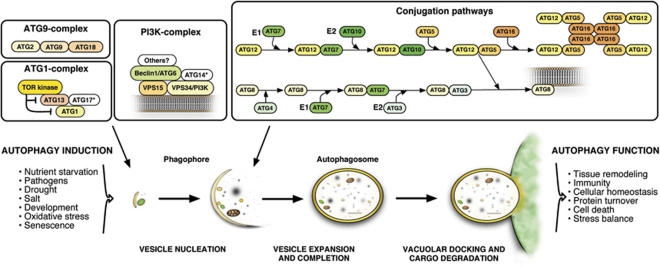Figure 1.
The autophagy pathway in plants. Upon induction by environmental and developmental stimuli, macroautophagy starts by nucleation and expansion of a pre-autophagosomal membrane, the phagophore, which engulfs cytoplasmic material destined for degradation. Autophagosomes are then transported to and dock with the vacuole, which leads to release of the inner single-membrane vesicle, the autophagic body, into the vacuolar lumen and hydrolytic breakdown of the enclosed cargo. Autophagy induction and vesicle nucleation require the action of the TOR kinase and ATG1-complex, which activates the class III PI3K complex containing ATG6/Beclin1 and possibly other yet unknown interactors. Additionally, as known from other eukaryotes, the ATG9 complex is required for recycling and retrieval of autophagy proteins, but this function awaits verification in plants. Membrane elongation and autophagosome formation require the action of two-ubiquitin-like conjugation systems, which modify two ubiquitin-like molecules, ATG5 and ATG8, to mediate association with the phagophore and its subsequent folding and expansion. *ATG proteins not identified in plants yet

